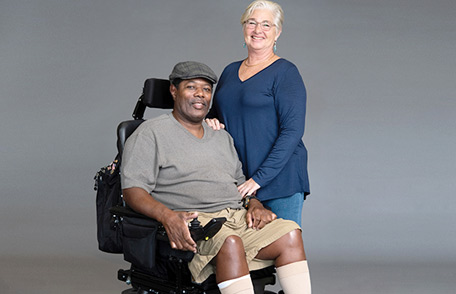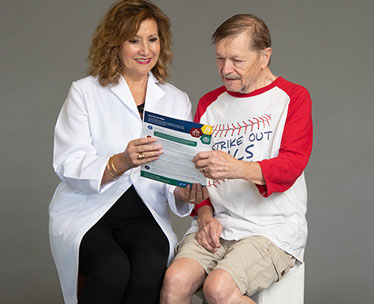The National ALS Registry

This October marks 13 years since the National ALS Registry was established and began enrolling people living with ALS. Researchers have made progress in the past decade in learning more about ALS; however, there is still a long way to go to fully understand the disease. Despite remaining knowledge gaps in ALS research, the Registry is extremely grateful for the participation from all the people living with ALS around the country. Learn more about the National ALS Registry at cdc.gov/als.
What is ALS?
Amyotrophic lateral sclerosis (ALS), also known as Lou Gehrig’s disease, is a rapidly progressive, fatal neurological disease that affects nerve cells in the brain and spinal cord, causing nerves in the muscle to die, thereby affecting voluntary muscle movement. On average, persons with the disease die within two to five years after being diagnosed. We still know very little about ALS, including its cause(s) and why ALS strikes some people and not others, but the Registry continues to work to better understand the disease.
How is the Registry fulfilling its goals?
Since the Registry’s launch, the Centers for Disease Control and Prevention (CDC)/Agency for Toxic Substances and Disease Registry (ATSDR) have been able to provide information about the incidence, prevalence, and demographic characteristics of persons living with ALS in the U.S. The Registry’s seventh report was published in August 2023 and includes findings from 2018. This report estimates that almost 30,000 people were living with ALS in the U.S. ALS continues to be more common in whites, males, and persons between the ages of 60-69. The Registry continues to develop upon its means of capturing cases of ALS across the country and this year used an improved method of capture-recapture to identify missing cases of ALS and give a more accurate estimate of the disease burden in the United States.
ATSDR is also conducting several different activities to examine the potential risk factors for ALS. Through the Registry’s 18 online risk factor modules, ATSDR is collecting detailed information from persons living with ALS on topics such as occupation, military history, residential history, and trauma history, to better learn about the potential risk factors for developing the disease. To date, over 110,000 survey modules have been completed by persons living with ALS.
Continuing Education
One of the difficulties faced in identifying new ALS cases is the lack of or difficulty of access to specialized care in ALS. The only health care provider many patients have access to is their primary care provider and many are not well equipped to address ALS diagnoses and the help with care and recommendations afterwards. To that end, the National ALS Registry had developed a Continuing Education course to teach healthcare providers how to recognize ALS symptoms, how to better communicate the next steps in treatment and care with the patient, and how to talk about the importance of the Registry and enrollment. The CE course has been revised and updated in 2023 with the latest findings in ALS research and recommendations from experts in the ALS community. The CE course can be found here: National ALS Registry Continuing Education Module.
Research
Research is critical to helping scientists and persons living with ALS better understand the disease. The overarching goal of the research is to examine potential risk factors for developing ALS. To help identify these potential risk factors, the Registry’s Research Notification Mechanism connects individuals with ALS with scientists who are recruiting participants for their ALS studies and clinical trials. Since the notification mechanism became available, over 90% of Registry-enrolled persons with ALS have chosen to receive email notifications about research opportunities for which they are eligible. To date, ATSDR has helped over 70 studies, both domestically and abroad, recruit thousands of patients for research.
Funding
ATSDR is also providing funding for academic institutions to conduct research to learn more about risk factors and what may cause ALS. In 2023 alone, the National ALS Registry funded two projects, from the University of Michigan Ann Arbor and The ALS Therapy Development Foundation, to study the interactions between exposures and genetics in the development of ALS and to study risk factors for ALS. Additionally, Registry is calling for research applicants for a brand new Funding Opportunity from ATDSR to identify ALS risk factors. To date, ATSDR has funded 24 domestic research studies and 2 international studies. Information gleaned from the research will help ATSDR prioritize topics for future surveys.
National ALS Biorepository

The more people living with ALS who join the Registry, the more complete of a picture we can create of the disease and the better we can aid research efforts in finding a potential cause.
The National ALS Registry (Registry) is also closing in on the 8-year anniversary of the National ALS Biorepository (Biorepository). The Biorepository continues to enroll a representative, population-based sample of Registry participants. During in-home collections Biorepository participants can provide biological samples such as blood or saliva. This service is provided at no cost to the persons with ALS. Once collected and stored these samples are available for future ALS research so that researchers may better understand the cause(s) of ALS. The relationship between the Registry and Biorepository allows for the correlation of biomarkers with extensive epidemiologic data collected by the Registry. To date, over 80,000 samples are currently available for scientists to use in their research.
ALS Research Counts on You
The more people living with ALS who join the Registry, the more complete of a picture we can create of the disease and the better we can aid research efforts in finding a potential cause. We encourage everyone to learn more about the Registry and how it is moving the fight forward against ALS. Learn more about the National ALS Registry.

